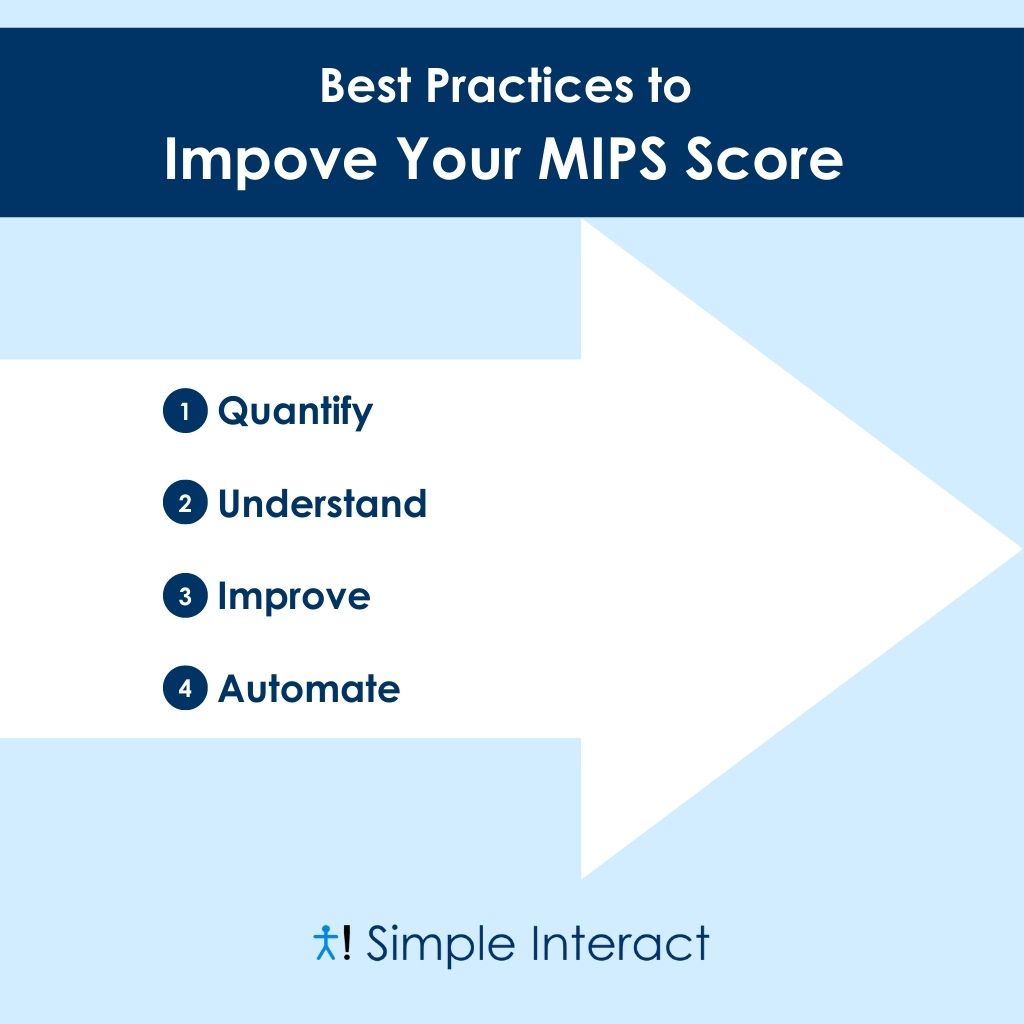The Practical Guide to Improving Your MIPS Score (and Saving $24K/Year per Provider)

The Merit-Based Incentive Payment System score, or MIPS score, determines future Medicare payment adjustments for your practice, both bonuses and penalties. The score itself comes from measurements in four specific categories and is determined by a point system.
Earning less than 75 points on your MIPS score means a negative payment adjustment, while scoring over 75 means a positive payment adjustment. The exact rules are complex and ever-changing, and the fickle nature of the MIPS score often discourages medical practices from even attempting to put a plan in place to improve their scores and avoid a penalty.
We don’t want to see practices relinquishing revenue due to a convoluted penalty system, so we’ve created this simple MIPS guide with practical advice for improving your MIPS score and saving $24K per provider each year.
Quantify How Your MIPS Score Impacts Your Revenue
First, let’s run some numbers to determine whether the effort to improve your practice’s MIPS score is even worthwhile.
Say your total annual revenue is $10M, and most of the time 30% of this revenue comes from Medicare patients. In this case, there can be a 9% negative adjustment on that 30%, which translates to a 2.7% negative adjustment on annual revenue.
That’s a $270K loss per year if you take no action whatsoever.
Or let’s say you’re a specialty provider, like an orthopedic group. According to the national average, the annual revenue of an orthopedic provider is around $900K per year. If 30% (or $270K) of that revenue comes from Medicare, a 9% penalty equals $24,300 per provider.
If you have 20 providers suffering MIPS penalties, that’s nearly $500K of losses in yearly practice revenue. That’s not chump change.
Understand the Rules of the Game
MIPS isn’t the only program available for incentive payments (and penalties). A host of Alternative Payment Models, or APMs, also offer value-based payments based on quality and cost of medical care.
Practices can choose between a MIPS or APM route based on their tolerance and appetite for risk versus reward. In general, MIPS tends to be a simpler system, and APMs carry more risk. Read more about MIPS versus APM routes in athenahealth’s article on deciding between MIPS and APMs.
If you choose MIPS, it’s important to note the different requirements for small practices compared to large practices, and know that these requirements may change from year to year. For example, the 2022 minimum requirement is 75 points, up significantly from 60 points in 2021.
Improve With Best Practices
If the calculations above have convinced you that your MIPS score is a problem worth solving, take a look at some best practices we’ve identified through working closely with medical providers.
We find that mapping your optimal path to a great score is easiest when you start from your goal of 75 points and work backwards. Below are the four main categories that determine your MIPS score, prioritized by how much control you have over each.

1. Improvement Activities
The lowest-hanging fruit among the four categories is Improvement Activities, because these fall under your direct control. You can earn a maximum of 15 points by completing improvement activities like:
- Using a clinical decision support system (CDSS)
- Adopting a prescription drug monitoring program (PDMP)
- Implementing referral tracking and increasing your rate of closed referral loops
- Increasing patient access with methods like telehealth
- Capturing patient information through a certified electronic health records program
You can choose from a host of improvements, all of which result in a boost to your MIPS score.
2. Promoting Interoperability
The next category to focus on is Promoting Interoperability, worth 25 points. We could dive down into all the gritty details about promoting interoperability, but the simplest way to maximize these points is to employ an electronic medical records (EMR) system that already has interoperability embedded into it.
A good EMR will help you achieve most of this category’s points with little fuss, though it won’t hit all of them. To determine whether your system is getting you effective results, take a look at what other medical practices typically achieve in this category. If you can beat the national average of points, you’re golden.
3. Quality Measures
Next, consider the best way to earn the 30 points in the MIPS Quality Measures category — obtained through Physician Quality Reporting System (PQRS) data capture. This is the area where customizable software can help give your MIPS score the biggest boost.
The quality performance category includes six collection types:
- eCQMs (Electronic Clinical Quality Measures)
- CQMs (Clinical Quality Measures)
- QCDR (Qualified Clinical Data Registry) Measures
- Claims measures for Medicare Part B
- Measures for CMS Web Interface
- Consumer Assessment of Healthcare Providers and Systems (CAHPS) for MIPS Survey
Keep in mind you’ll need to submit performance data for a minimum of 70% of qualifying patients in each category. You have a wide variety of options in this category, and implementing measures for all of them doesn’t make strategic sense for most practices.
Instead, get to the 30 points by identifying six to eight of the easiest measures your practice can work toward. Consider those that will get you the maximum score with minimum effort. If collecting one measure gives you five points and another only provides a single point, then go with the former.
Since MIPS requirements can differ by specialty, it’s important to research the most optimal and appropriate set of quality measures to capture for your specialty area. If your practice has multiple sub-specialties, look for measures that work across the full range, such as:
- Documentation of current medications
- Most recent colorectal cancer screening
- Most recent mammogram screening
- Smoking status
One pro-tip we’ve discovered is to watch for data capture opportunities that will improve both your Improvement Activities and Quality Measures scores.
4. Cost
The Cost category asks how you’ve contributed to reduce the overall cost of patient treatment. It’s the least controllable category on the list, but you can still aim for a minimum of 10 of its 30 points.
How you reduce cost will depend on your specialty and the types of treatments you provide. It could mean offering after-hours or telehealth care to reduce emergency room visits, or in some cases it could mean offering more cost-efficient treatments that deliver results similar to pricier options.
Embrace Automation
Incorporating more automation can significantly reduce the burden of implementing steps to improve your MIPS score. Automation is one less thing your staff needs to worry about, and it will cost you less in staff hours. Plus, tracking and reporting by staff won’t be as consistent as using a customizable software — and consistency is essential to earning your MIPS points.
Here are a few tips for embracing automation:
- Incorporate the MIPS Quality Measures we discussed into your digital patient intake and digital check-in processes via automation.
- Design your MIPS questions to be simple and clear for patients to answer.
- Only ask questions appropriate to each patient. For example, only include a breast cancer screening question for women who are between 50 and 74 years old, and only ask this question every 18 months.
The most efficient and cost-effective thing you can do is to use a purpose-built system that you can simply turn on. There’s no need to reinvent the wheel to improve your MIPS score.
Practice Administrator Joseph Mathews incorporated Simple Interact’s automation software at Advanced Orthopaedics & Sports Medicine (a division of OrthoLoneStar) and made MIPS data capture part of their digital patient intake and check-in processes. He says,
“To combat the high cost of training and implementation of the ever-changing merry-go-round rules of MIPS, I have found automation of select MIPS measures to be the most efficient and cost-effective way to avoid the up to 9% of negative adjustments for noncompliance.”
MIPS Guide: Final Thoughts
To boost your MIPS score, you will need a practical, thoughtful approach. You don’t want to spend $8 to save $10 when spending $2 can achieve the same result — and is much more palatable.
Instead of trying to come up with a completely new system from scratch, take advantage of this MIPS guide’s best practices and the customizable software solutions that already exist — like Simple Interact. That way, you can boost your MIPS score without placing an undue burden on your team’s time and resources.

Ravi Kalidindi is the Founder and CEO of Simple Interact, a leading Front Office Automation company that helps healthcare facilities across the United States run more efficiently and profitably by boosting staff productivity, reducing provider burnout, and elevating the patient experience. Customers view Ravi as a trusted partner who can quickly comprehend business problems and suggest “keep it simple” solutions that are effective and easier to maintain over time.
Recent Posts
- The Benefits of Using 2-Way SMS Chat for Healthcare Communication
- 2-Way SMS vs. Live Chat: Which Is Best for Bi-Directional Patient Communication?
- Simple Interact Earns A+ Satisfaction Ratings in KLAS Report
- Boosting Healthcare Staff Productivity With a Shared Inbox Dashboard
- Healthcare SMS: What Metrics to Track in Your 2-Way SMS
Categories
Archives
- February 2025
- June 2024
- May 2024
- April 2024
- March 2024
- February 2024
- January 2024
- December 2023
- November 2023
- October 2023
- September 2023
- August 2023
- July 2023
- June 2023
- May 2023
- April 2023
- March 2023
- February 2023
- January 2023
- December 2022
- November 2022
- October 2022
- September 2022
- August 2022
- July 2021
- December 2020
- May 2020
- March 2020
- June 2016